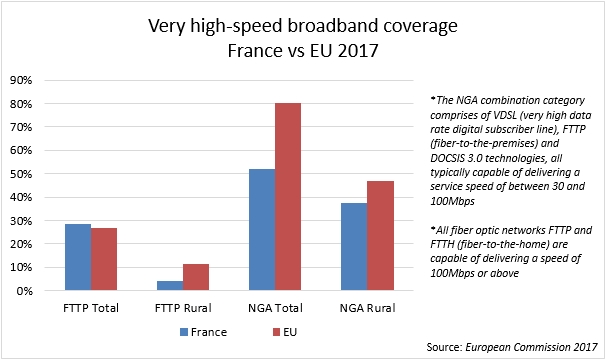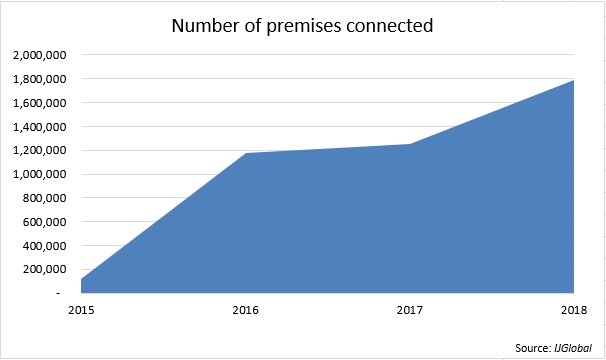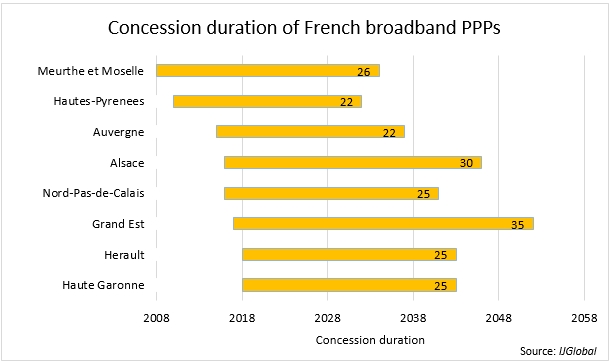The French broadband connection
In early December 2018, French telecoms majors Bouygues and Axione signed a partnership with Mirova to deliver a fibre optic network across France’s very densely populated areas, also known as zones noires or “black areas”. The agreement is part of an initiative to extend fibre optic networks across the country.
France is known for having one of Europe’s least developed very-high-speed broadband networks at local level. Uneven distribution of coverage means high-speed broadband networks exist primarily in the black areas, while less populated semi-urban and rural areas (zones blanches – "white areas") are being left behind. A report by the European Commission published in 2017 clearly shows that there is a significant lag in French rural areas.
As early as 2013 the government launched the Plan France Très Haut Débit (the "Broadband Programme" or THD). This involved private funding for fibre optic networks to provide a faster alternative to the existing copper ADSL (asymmetric digital subscriber line) digital infrastructure. At the time, the government's objective was to achieve 100% coverage across France by 2022 – primarily using fibre optic cable – at a total cost of €20 billion ($23 billion), of which €13.3 billion was to be funded by the state.
However, the coverage gap between zones meant that a single solution would not suffice.
Traditional telecoms operators have been eager to compete and spare no resource to develop their existing networks in densely populated cities, mostly thanks to the minimal risk involved.
While busy cities correspond to about 20% of France’s population, the situation in the white areas, accounting for nearly half of the country, is not quite the same. Building investment-heavy infrastructure in these parts is less attractive due to lower returns and higher risk. Therefore, local authorities have stepped in and awarded concession contracts under a PPP model.
| PPP projects | Project value ($m) | Financial close year |
| Grand Est Broadband | 1,321 | 2017 |
| Herault Broadband | 431 | 2018 |
| Nord-Pas-de-Calais Broadband | 402 | 2016 |
| Alsace High-Speed Broadband | 377 | 2016 |
| Haute Garonne High-Speed Broadband | 295 | 2018 |
| Meurthe et Moselle Broadband | 210 | 2008 |
| Auvergne Broadband | 174 | 2015 |
| Hautes-Pyrenees Broadband | 49 | 2010 |
| TOTAL | 3,259 |
As shown by IJGlobal data, a number of big white-zone broadband projects closed in recent years, all of which were procured as PPPs with durations of between 25 and 35 years.
Although expectations have been that traditional telecoms operators, which tend to focus on the black areas, would leave space for new entrants in the less profitable areas, reality turned out to be less straightforward.
High investment – coupled with low returns – led to a slowdown in development. Faced with missing the programme’s deadlines, President Macron introduced substantial changes to the agenda.
It was decided that targeted coverage was to be achieved earlier (in 2020), however the programme was no longer intended to be "all fibre optic". It would also use alternative 4G, upgrading copper wire ADSL networks and satellite communication technologies and permitting slower connections.
A series of measures were set in motion, aimed at incentivising operators and imposing sanctions on those who are unwilling to participate in the less profitable areas.
The redesigned broadband programme is the subject of intense discussions between the government and telecoms operators. Although there is uncertainty about the effect of the new 2020 targets, there is little doubt that the French broadband PPP market will remain active in the coming years.
Request a Demo
Interested in IJGlobal? Request a demo to discuss a trial with a member of our team. Talk to the team to explore the value of our asset and transaction databases, our market-leading news, league tables and much more.


